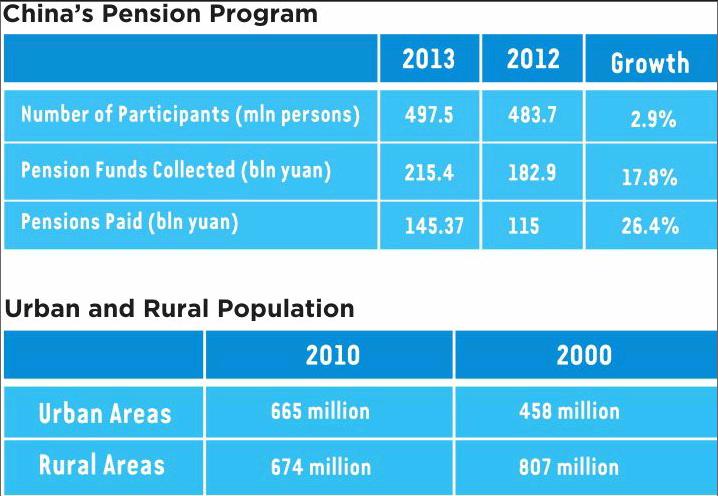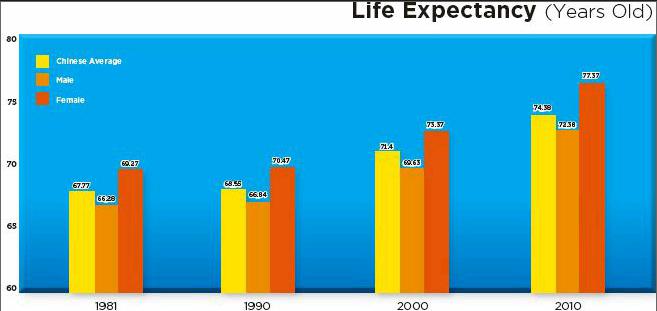A FAIR ShARE
2014-03-11ByLanXinzhen
By+Lan+Xinzhen



The State Council, Chinas cabinet, decided at an executive meeting on February 7 to integrate the basic pension systems for urban and rural residents. This is considered to be an important step by the Chinese Government in pushing forward social reform. It indicates that China has begun the arduous task of comprehensively deepening its reforms.
The urban-rural gap is commonly considered to be the most visible sign of inequality in China, and the disparity in the pension program between urban and rural residents is one of the most pressing issues related to this area which has been called into question in recent years.“To establish a unified basic pension system for urban and rural residents is a significant breakthrough. This means China will step into a new stage of advancing urban-rural integration,”said Li Guoxiang, a researcher with the Rural Development Institute of the Chinese Academy of Social Sciences (CASS).
To accelerate the integration of pension systems for urban and rural residents, the Chinese Government requires strong budgetary support. The State Council executive meeting stressed that the Central Government will fully subsidize the basic pension for the central and western regions and offer a 50-percent subsidy to the basic pension for the eastern region. At the meeting, it was specifically stated that local governments would be required to pay part or all of the minimum pension for low-income groups and encourage charitable organizations to give financial assistance to participants in pension schemes.
In 2009, China initiated pilot projects for unifying pension plans for urban and rural residents in Shanxi, Anhui and some other provinces. Li Zhong, spokesman of the Ministry of Human Resources and Social Security (MOHRSS), said that at present, 15 provinces have established uniform basic pension systems for urban and rural residents, offering examples to the rest of the country.
Bridging the divide
Currently in China, the pension plans for government officials, public institution staff, enterprise employees, rural residents and unemployed urban residents are different. A unified pension system for urban and rural residents will integrate pension plans for rural residents and unemployed urban residents, which were introduced in 2009 and 2011, respectively, and which now cover the majority of the countrys population.
Under the dual pension system, rural residents and unemployed urban residents are subject to unequal treatment, and pensions for urban residents are five to 10 times the amounts farmers can get.endprint

More importantly, such inequality has already had negative impacts on economic and social development. According to the MOHRSS figures, there are over 200 million migrant workers in China, 70 percent of whom are working permanently in cities. However, they can only participate in pension schemes in their hometowns, and not the places in which they are working. According to the MOHRSS, more than 30 million migrant workers have abandoned their pensions.
Li said after urban and rural pension plans are integrated, urban and rural residents will be able to enjoy the same rights and almost the same amount of pension entitlement. The State Council executive meeting proposed the introduction of uniform social security cards across the country, which will remarkably improve the management of pensions and prepare for the free transfer of pensions between different regions in the future.
In short, the fact that the pension system will become more equitable and that pensions can be freely transferred as participants move will better meet the demand of the labor flow required for Chinas economic growth.
More benefits
Yang Yansui, Director of Research Center of Employment and Social Security at Tsinghua University, said a unified basic pension system reflects social equality. The Third Plenary Session of the 18th Central Committee of the Communist Party of China proposed to “establish a fairer and more sustainable social security system.” Therefore, integrating the pension system for urban and rural residents is but one step toward fully achieving this goal.
According to Yang, unifying the pension system is also an important measure to implement the Party meetings decision to integrate urban and rural development. It is also a supporting policy in reforming the household registration system and establishing a unified labor market.
Pension, education and healthcare are the three most prominent areas of inequality brought about by Chinas household registration system, which discriminates between urban and rural areas.
After a unified pension system is set up, pension standards for citizens will no longer be decided by the type of their household registration, but by the price levels and cost of living of the place where they are living. Integrating the basic pension systems for urban and rural residents will accelerate the end of Chinas dual household registration system that has existed for over 60 years.endprint
Li said an integrated pension system will also help raise Chinese peoples spending power. Since Chinas social security system is still weak, many people, both in cities and the countryside, have to save more money for healthcare and their old age. This has reduced potential consumption, and thats why household consumption has not increased significantly in spite of the Chinese Governments efforts to stimulate domestic demand.
Li said among the countrys 1.3-billion people, 70 percent are rural residents. After the pension systems are integrated, rural areas will receive more support. With fewer worries for their old age, rural residents may be willing to save less and spend more.
To stimulate consumption with an integrated pension system may be the wish of Chinas top leaders. The State Council executive meeting particularly pointed out that establishing a unified basic pension system for urban and rural residents so as to make all the citizens enjoy equal basic old-age security is vital to Chinas economic and social development and is a prerequisite to advancing industrialization, IT applications, urbanization and agriculture modernization. This is conducive to boosting labor flow and ensuring that public expectations on the steady improvement of living standards are met. It will also play a significant role in stimulating consumption and in encouraging people to start up their own businesses.
Wang Zhenyao, Director of China Philanthropy Research Institute affiliated to Beijing Normal University, said integrating the pension system will encourage future reforms. It is actually laying the foundation for the realization of equal basic public services by 2020.
Besides pensions, there are also insistent appeals for unifying medical insurance systems for urban employees, unemployed urban residents, government employees and public institution staff, as well as allowing the free transfer of medical insurance between different regions.
Based on the ethos of boosting social equality, wider and deeper reforms are also worthy of expectation. “A unified pension system breaks through the separated systems between urban and rural areas, and more systematic barriers should be broken in the future,” said Wang.
Challenges remain
Li said the accumulated fortune brought about by the reform and opening up serves as a support for unifying social welfare between urban and rural areas. However, this does not mean China has enough financial strength to eliminate the urban-rural gap immediately. Ensuring timely payment of pensions will be the biggest challenge in implementing a unified basic pension system for urban and rural residents.endprint
China has been facing serious financial pressure on its pension funds in recent years. The regions which have, since 2009, been subject to pilot programs for a unified basic pension system have been unable to solve problems such as low pension levels. A shortage of money has been the major reason.
Pension funds are pooled by individuals, employers and the government. Unifying the basic pension systems for urban and rural residents means that pensions for farmers will increase and the government will have to provide more subsidies to the pension pools. The rate of aging population in Chinas rural areas is higher than that of urban areas. Calculating with the pension standard in 2013, the Chinese Government needs to offer an additional subsidy of 300 billion yuan ($49.1 billion) each year.
Zheng Bingwen, Director of the Center for International Social Security Studies of the CASS, said the process of unifying the basic pension systems for urban and rural residents comprises two aspects: the transfer of pensions for migrant workers in cities, which is not very difficult; the other is to unify pensions in different regions. For financial reasons, some local governments, especially those in under-developed regions, will obviously not be enthusiastic about doing so.
According to Zheng, most of the pensions paid for rural residents and unemployed urban residents come from transfer payments from the Central Government, followed by funds from local governments, while rural collective economic organizations contribute very little. Such a structure of financial sources will impose very little pressure on the budgets of community-level governments.
Social equality should be considered from a nationwide perspective. How to unify pension standards not only for urban and rural residents, but for all is one of the most contentious and important issues China faces today.endprint
